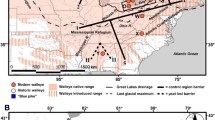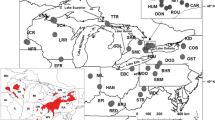Abstract
The relict dace (Relictus solitarius) is an endemic minnow restricted to isolated spring systems within Butte, Goshute, Ruby and Steptoe valleys in the eastern Nevada portion of the Great Basin. It is the only native fish in these basins, but speckled dace (Rhinichthys osculus) have been introduced into some localities in Ruby Valley and, based on morphology, the two species are believed to have hybridized in those areas. We used DNA sequence data from one mitochondrial gene (cytochrome b) and one nuclear intron (S7) to determine if putative relict dace populations in Ruby Valley share mtDNA haplotypes with speckled dace, or show signs of hybridization. Results of our analyses show that 11 of 16 Ruby Valley populations sampled contain only speckled dace, and one speckled dace population exhibited signs of limited introgressive hybridization. The remaining five Ruby Valley populations that were sampled contain relict dace that remain genetically distinct from speckled dace. The integrity of the Ruby Valley relict dace populations should be actively protected, particularly in the area surrounding Ruby Lake where speckled dace have been widely introduced.




Similar content being viewed by others
References
Aspinwall N, McPhail JD, Larson A (1993) A long-term study of hybridization between the peamouth, Mylocheilus caurinus, and the redside shiner, Richardsonius balteatus, at Stave Lake, British Columbia. Can J Zool 71:550–560
Billman EJ, Lee JB, Young DO, McKell MD, Evans RP, Shiozawa DK (2010) Phylogenetic divergence in a desert fish: differentiation of speckled dace within the Bonneville, Lahontan, and upper Snake River basins. West N Am Nat 70:100–108
Bufalino AP, Mayden RL (2010) Molecular phylogenetics of North American phoxinins (Actinopterygii: Cypriniformes: Leuciscidae) as inferred from S7 nuclear DNA sequence data. Mol Phylogenet Evol 55:143–152
Chen W, Mayden RL (2009) Molecular systematics of the Cyprinoidea (Teleostei: Cypriniformes) the world’s largest clade of freshwater fishes: further evidence from six nuclear genes. Mol Phylogenet Evol 52:544–549
Chow S, Hazama K (1998) Universal PCR primers for S7 ribosomal protein gene introns in fish. Mol Ecol 7:1255–1256
Clement M, Posada D, Crandall KA (2000) TCS: a computer program to estimate gene genealogies. Mol Ecol 9:1657–1660
Dmitriev DA, Rakitov RA (2008) Decoding of superimposed traces produced by direct sequencing of heterozygous indels. PLoS Comput Biol 4(7):e1000113
Dowling TE, DeMarais BD (1993) Evolutionary significance of introgressive hybridization in cyprinid fishes. Nature 362:444–446
Estabrook GF, Smith GR, Dowling TE (2007) Body mass and temperature influence rates of mitochondrial DNA evolution in North American cyprinid fish. Evolution 61:1176–1187
Excoffier L, Laval G, Schneider S (2005) Arelquin ver. 3.0: an integrated software package for population genetics data analysis. Evol Bioinformatics Online 1:47–50
Fausch KD, Rieman BE, Dunham JB, Young MK, Peterson DP (2009) Invasion versus isolation: trade-offs in managing native salmonids with barriers to upstream movement. Conserv Biol 23:859–870
Frissell CA (1993) Topology of extinction and endangerment of native fishes in the Pacific-Northwest and California (USA). Conserv Biol 7:342–354
Fu YX (1997) Statistical tests of neutrality of mutations against population growth, hitchhiking and background selection. Genetics 147:915–925
Geist J (2011) Integrative freshwater ecology and biodiversity conservation. Ecol Indic 11:1507–1516
Grady JM, Cashner RC (1988) Evidence of extensive intergeneric hybridization among the cyprinid fauna of Clark Creek, Wilkinson Co., Mississippi. Southwest Nat 33:137–146
Guindon S, Gascuel O (2003) A simple, fast, and accurate algorithm to estimate large phylogenies by maximum likelihood. Syst Biol 52:696–704
Houston DD, Shiozawa DK, Riddle BR (2010a) Phylogenetic relationships of the western North American cyprinid genus Richardsonius, with an overview of phylogeographic structure. Mol Phylogenet Evol 55:259–273
Houston DD, Ogden TH, Whiting MF, Shiozawa DK (2010b) Polyphyly of the pikeminnows (Teleostei: Cyprinidae) inferred using mitochondrial DNA sequences. Trans Am Fish Soc 139:303–315
Houston DD, Shiozawa DK, Riddle BR (2011) The roles of Neogene geology and late Pleistocene lake levels in shaping genetic structure of the Lahontan redside shiner Richardsonius egregius (Teleostei: Leuciscidae). Biol J Linn Soc 104:163–176
Hubbs CL, Miller RR (1948) The zoological evidence: correlation between fish distribution and hydrographic history in the desert basins of Western United States. In: The Great Basin, with emphasis on glacial and postglacial times. Bull Univ Utah, Biol Series 10, no. 38, pp. 17–166
Hubbs CL, Miller RR (1972) Diagnoses of new cyprinid fishes of isolated waters in the Great Basin of western North America. Trans San Diego Soc Nat Hist 17:101–106
Hubbs CL, Miller RR, Hubbs LC (1974) Hydrographic history and relict fishes of the north-central Great Basin. Mem Calif Acad Sci. San Francisco
Huelsenbeck JP, Ronquist F (2001) MrBayes: Bayesian inference of phylogenetic trees. Bioinformatics 17:754–755
Jobb G (2008) TREEFINDER version of October 2008. Munich. Distributed by the author at www.treefinder.de
Katoh K, Toh H (2008) Recent developments in the MAFFT multiple sequence alignment program. Brief Bioinform 9:286–298
Kauwe JS, Shiozawa DK, Evans RP (2004) Phylogeographic and nested clade analysis of the stonefly Pteronarcys californica (Plecoptera: Pteronarcyidae) in the western USA. J N Am Benthol Soc 23:824–838
Librado P, Rozas J (2009) DnaSP v5: a software for comprehensive analysis of DNA polymorphism data. Bioinformatics 25:1451–1452
Maddison DR, Maddison WP (2005) MacClade 4: analysis of phylogeny and character evolution. Version 4.08. Sinauer Associates, Sunderland
Martin AP, Wilcox JL (2004) Evolutionary history of Ash Meadows pupfish (genus Cyprinodon) populations inferred using microsatellite markers. Conserv Genet 5:769–782
McKell MD (2003) Phylogeography of speckled dace, Rhinichthys osculus (Teleostei: Cyprinidae), in the intermountain west, USA. MS Thesis, Brigham Young University
Minckley WL, Hendrickson DA, Bond CE (1986) Geography of western North American freshwater fishes: description and relationships to intra-continental tectonism. In: Hocutt CH, Wiley EO (eds) The zoogeography of North American freshwater fishes. Wiley, New York, pp 519–614
Oakey DD, Douglas ME, Douglas MR (2004) Small fish in a large landscape: diversification of Rhinichthys osculus (Cyprinidae) in western North America. Copeia 2004:207–221
Posada D (2008) jModelTest: phylogenetic model averaging. Mol Biol Evol 25:1253–1256
Schlyer K (2007) Gambling on the water table: the high stakes implications of the Las Vegas pipeline for plants, animals, places and people. Defenders of Wildlife, Washington 18 pp
Smith GR (1973) Analysis of several hybrid cyprinid fishes from western North America. Copeia 1973:395–410
Smith GR (1981) Late Cenozoic freshwater fishes of North America. Ann Rev Ecol Syst 12:163–193
Smith GR (1992) Introgression in fishes: significance for paleontology, cladistics, and evolutionary rates. Syst Biol 41:41–57
Smith GR, Dowling TE, Gobalet KW, Lugaski T, Shiozawa DK, Evans RP (2002) Biogeography and timing of evolutionary events among Great Basin fishes. In: Hershler R, Madsen DB, Currey DR (eds) Great Basin aquatic systems history. Smithsonian contributions to the Earth Sciences Number 33, Smithsonian Institution Press, pp 175–234
Tajima F (1989) Statistical method for testing the neutral mutation hypothesis by DNA polymorphism. Genetics 123:585–595
Unmack PJ, Bennin A, Habit EM, Victoriano PF, Johnson JB (2009) Impact of ocean barriers, topography, and glaciation on phylogeography of the catfish Trichomycterus areolatus (Teleostei: Trichomycteridae) in Chile. Biol J Linn Soc 97:876–892
Vigg S (1982) Temperature and salinity relationships of the Nevadan relict dace. Gt Basin Nat 42:541–548
Williams OR, Albright JS, Christensen PK, Hansen WR, Hughes JC, Johns AE, McGlothlin DJ, Pettee CW, Ponce SL (1996) Water rights and Devil’s hole pupfish at Death Valley National monument. In: Halvorson WL, Davis GE (eds) Science and ecosystem management in the national parks. University of Arizona Press, Tucson, pp 161–183
Acknowledgments
The dace samples used in this study were provided by Chris Crookshanks, Jeff Peterson, and John Elliot (NDOW), and by Kelsey McCutcheon, Jenna Wood, and Jessica Saenz (OBEC). Gerald R. Smith provided comments that helped improve the quality of the manuscript, and was very generous in providing a summary of the results from an unpublished morphological study. Verity Mathis and four anonymous reviewers also provided comments that helped improve the manuscript. Ed Wilcox prepared samples for sequencing once they were submitted to the BYU DNA Sequencing Center. Funding was provided by the Ruby Lake National Wildlife Refuge, and by the Fish Phylogenetics Program at Brigham Young University.
Author information
Authors and Affiliations
Corresponding author
Appendices
Appendix A
Sub-trees representing each of the clades that were collapsed on the cyt b phylogeny (Fig. 2). Terminal taxa are labeled using the population abbreviation for the location where the individual was sampled (listed in Table 1) followed by that individual’s assigned BYU number. Most nodes within the relict dace clade or the speckled dace clade were not well supported, but those that did receive moderate to good support have ML bootstrap values listed above nodes and posterior probabilities are below nodes.

Appendix B
Sub-trees representing each of the clades that were collapsed on the S7 phylogeny (Fig. 3). Terminal taxa are labeled using the population abbreviation for the location where the individual was sampled (listed in Table 1) followed by the individual BYU number that was assigned to that specimen. Most nodes were not well supported, but for those that were, ML bootstrap values are listed above nodes and posterior probabilities are below nodes.

Rights and permissions
About this article
Cite this article
Houston, D.D., Evans, R.P. & Shiozawa, D.K. Evaluating the genetic status of a Great Basin endemic minnow: the relict dace (Relictus solitarius). Conserv Genet 13, 727–742 (2012). https://doi.org/10.1007/s10592-012-0321-6
Received:
Accepted:
Published:
Issue Date:
DOI: https://doi.org/10.1007/s10592-012-0321-6




